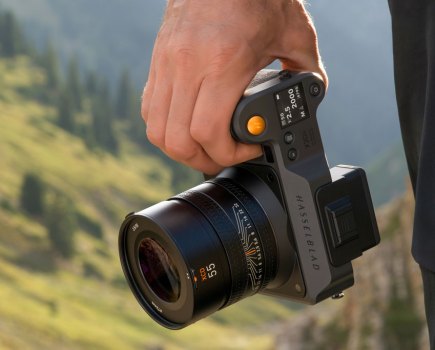Sony Alpha 5100 – introduction
Sony’s latest compact camera model, the Sony Alpha 5100 features some of the Japanese firm’s latest technology, including the 24.3-million-pixel Exmor APS HD CMOS sensor, with an sensitivity range of ISO 100-25,600 and the Bionz X processor seen in the more advanced Sony Alpha 6000. That camera’s 179-point hybrid AF system has also made it inside the Alpha 5100’s compact frame, delivering super-fast autofocusing – claimed to be as quick as 0.06secs – making it one of the fastest cameras currently on the market.
Rather than updating the Sony Alpha 5000, which was released earlier this year, the Alpha 5100 instead replaces the Sony NEX-5T, the final NEX-branded camera in the compact range, which will now be discontinued. This move finally consolidates all Sony’s E-mount compact system cameras and Alpha-mount SLTs under the Sony Alpha branding.

Sony Alpha 5100 – Features
Looking at the spec sheet for the Alpha 5100, it’s hard to see any weaknesses. It ticks most of the boxes that anyone in the market for a compact system camera could want, and in use, these features shine.
The 179-point AF with touchscreen focus functionality covers over 90% of the frame and can deliver incredibly quick focusing responses. This is because each of the camera’s AF points features on-chip phase detection, further enhanced by the inclusion of 25 precision contrast AF points positioned around the centre of the camera’s 24.3-million-pixel sensor.
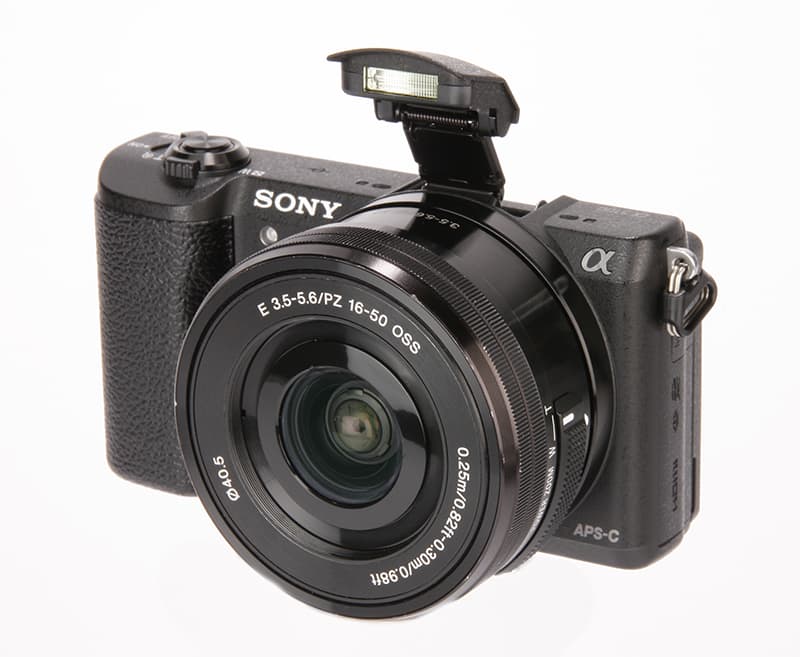
When shooting in low light, such opportunities can be better exploited with this camera’s sensitivity range of ISO 100-25,600, and Bionz X-enabled, area-specific noise reduction. However, a small pop-up flash with a guide number of 4m @ ISO 100 is also provided for shooting nearby subjects in extremely low light.

Despite the challenging metering scenario of a white subject in a dark setting, the camera exposed well for the entire scene
Sony E PZ 16-50mm F3.5-5.6 OSS
Sony Alpha 5100 – Specification
Price: £549 (with kit lens)
Sensor: 24.3-million-pixel, Exmor APS HD CMOS sensor
Output size: 6000 x 4000 pixels
Focal length mag: 1.5x
Lens mount: Sony E-mount
Shutter speeds: 30-1/4000sec, plus bulb
ISO: 100-25,600
Metering system: 1,200-zone evaluative
Exposure compensation: ±3EV in 1/3EV steps;
Movies: ± 2EV in 1/3EV steps
Drive mode: 6fps continuous shooting
LCD: 3in TFT with 921,600 dots
Viewfinder: No
AF points: Hybrid (179 phase-detection AF points)
Video: 1920 x 1080 pixels at 50p/50i/25p
External mic: No
Power: NP-FW50 (up to 400 shots)
Memory card: Memory Stick Pro Duo, SDHC/SDXC UHS-I
Dimensions: 109.6 x 62.8 x 35.7mm
Weight: 283g (with battery and card)
Video
Capable of recording full HD, 1920 x 1080-pixel movies in either cinematic 24 frames per second, or 50p/50i, the video recording capabilities of the Alpha 5100 surpass those of many DSLRs twice its size, and even its pricier relation, the Alpha 6000.
This is because Sony has made it possible to record broadcast-quality XAVC S 25p footage at a high bit-rate of 50Mb/s, or Blu-ray quality AVCHD, while simultaneously recording in the less hefty MP4 codec for uploading straight to web or creating rush edits.

Professional video makers can also use the Alpha 5100 to film uncompressed 8-bit 4:2:2 video using an external recording device connected via the clean HDMI port provided.
The only drawback is the lack of an input for an external microphone, but it is common for professionals to record audio separately so this may not be an issue for some.
Build and handling
Considering what has been packed into the Alpha 5100, it’s quite astonishing that Sony has managed to keep it so compact. Physically, it’s identical to the Alpha 5000, the world’s smallest APS-C-format camera, but weighs a fraction more. Yet due to its plastic construction, it only weighs 283g with a card and battery loaded, so it should fit comfortably into most jacket pockets when mounted with its kit lens. The Alpha 5100 is also comfortable enough when worn around the neck all day.
It’s distinctly obvious that this camera has been built to a price, but with that said, it doesn’t feel cheap. Its plastic exterior is tough and the plastic grip has a leatherised texture that is easy to hold when shooting, although a slightly deeper grip would have been ideal.
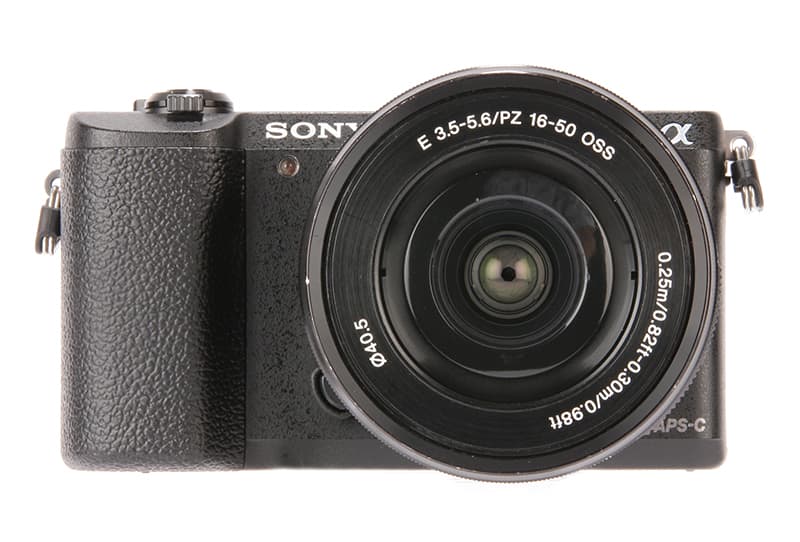 Capturing images on its 3in, 921,600-dot LCD screen can be done with the screen tilted upwards, or front-facing when taking self-portraits. It’s also possible to use the screen to point-focus and shoot, although touchscreen functionality is limited to taking pictures only.
Capturing images on its 3in, 921,600-dot LCD screen can be done with the screen tilted upwards, or front-facing when taking self-portraits. It’s also possible to use the screen to point-focus and shoot, although touchscreen functionality is limited to taking pictures only.
In use, the touchscreen is highly responsive, though it’s a shame that it wasn’t enabled during playback mode, at least for pinch-zoom and scrolling through images.
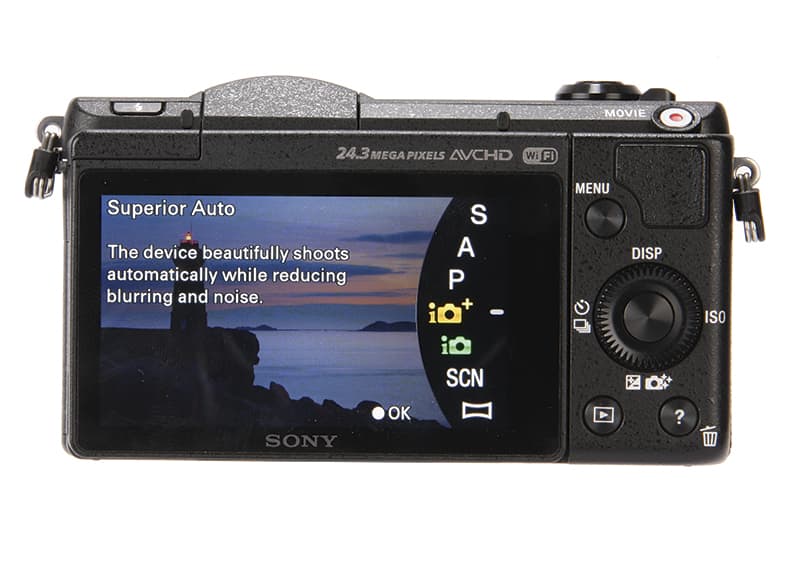
Resolution, dymanic range and noise
Resolution

From our test charts, the Alpha 5100 resolves around 3100 l/ph at ISO 100, which is much as we’d expect for a 24.3-million-pixel sensor with a low-pass filter. Resolution drops progressively as the sensitivity is increased and noise reduction comes into play, to around 2500 l/ph at ISO 1600 and 2000 l/ph at ISO 25,600.
Dynamic range
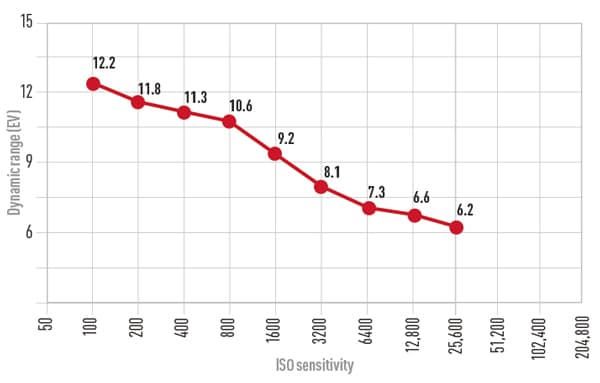
As we’d expect, the Alpha 5100 gives essentially identical results to the Alpha 6000. At ISO 100, it offers a very respectable 12.2EV range, which gives plenty of scope for extracting more shadow detail from raw files. At ISO 1600, it’s still very respectable at over 9EV, but at higher sensitivities, increasing shadow noise reduces the range.
Noise
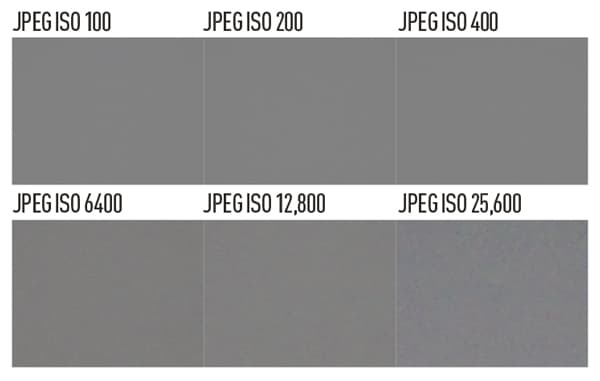
Low-ISO images are extremely clean, but luminance noise starts to creep in at ISO 800 and above. Both chroma noise and noise reduction artefacts become increasingly visible at higher sensitivities, with ISO 6400 and higher looking very noisy indeed, and best used only when absolutely necessary. In practice, ISO 1600-3200 enabled us to use fast-enough shutter speeds to freeze fast-moving subjects in low-light conditions.

At ISO 3200, the camera handles noise very well and captures a good level of fine detail
Sony E PZ 16-50mm F3.5-5.6 OSS
Performance
The speed and accuracy of the Alpha 5100’s autofocus is what really stands out. In my brief time using this camera with the Sony E PZ 16-50mm f/3.5-5.6 OSS kit lens, I didn’t get a single out-of-focus shot.
With a half-press of the shutter button, the camera actuates its focusing motors almost instantaneously and locks on to your target stubbornly when continuous AF is engaged. It’s possible to adjust AF drive speed and tracking separately: drive can be set to fast, normal and slow, while tracking duration can be set to normal and high.
I tested the AF-C function by focusing on a section of leaves in a bush that was being blown in an intermittently rushing wind. Even when set to normal, with a background that was challenging in that it was similar to the subject, the camera tenaciously held onto the section of blowing leaves that I had initially focused on.
Despite the camera’s limited number of physical controls and lack of full touchscreen functionality, navigating and operating the Alpha 5100 is very straightforward thanks to Sony’s simplified and user-friendly interface.
Pressing the centre button allows you to select from PASM modes, as well as scene, intelligent and superior auto modes, panoramic shooting and movie recording, using the multifunctional rear dial, while the inclusion of a power zoom lever on the shoulder of the camera makes it fully operable with just one hand.
Meanwhile, Wi-Fi and NFC connectivity open up the possibilities of wireless shooting, as well as sending images straight to a tablet or similar compatible device for improved image reviewing. I not only found these functions easy to set up, but image transfer speeds proved to be remarkably quick.
Our verdict
Given that this camera shares many of its core components with the Alpha 6000, I expected it to deliver the same superb image quality and it did not disappoint, ticking that box emphatically but at a more affordable price point.
Sony’s E-mount system now has something for everybody: the Alpha 5100 takes the impressive image-capturing technology from the more advanced Alpha 6000 and places it inside a truly compact body that has a simple and easy-to-use interface.
If you don’t need a viewfinder or the extra control dials of the Alpha 6000, but want more advanced stills and video capturing capabilities than those offered by the Alpha 5000 – particularly the higher-resolution sensor and superior autofocusing and tracking performance – the Alpha 5100 is a camera seriously worth considering.
For those needing quick AF and great video, it offers some top tech at a highly competitive price.
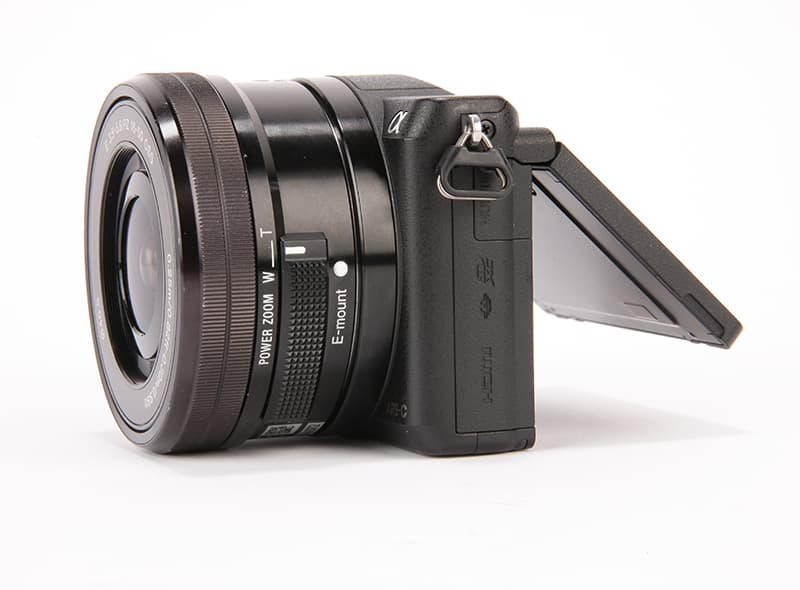
Key features
The Sony Alpha 5100 boasts a raft of features aimed at those who thrive on the latest tech
Play Memories
The Play – Memories mobile app from Sony allows you to shoot wirelessly and transfer images to compatible smartphones and tablets.
Dual video
Record full HD – 1920 x 1080-pixel video while simultaneously recording in MP4 codec.
Front-facing screen
Taking self-portraits is made much easier thanks to the Alpha 5100’s 180° flip screen.
E mount
Making use of Sony’s E-mount lens family, this is one of the world’s smallest interchangeable-lens cameras with an APS-C-sized sensor.
Touchscreen
Touch-focusing and shooting is highly responsive, but it is limited to shooting only.
Apps
Downloadable apps via the in-camera PlayMemories menu can expand the functionality of the camera, adding features such as time-lapse, star trail and motion shot.
Hands-on First Look
Sony says its new Sony Alpha A5100 is the world’s smallest interchangeable lens camera, but with its 24-million-pixel APS-C sensor it packs an impressive punch.
Sony Alpha A5100: Key Features
Sony was the originator of what’s become something of a standard design template for compact system cameras, with its original NEX-3 and NEX-5 models back in 2010. These were triumphs of miniaturisation, with APS-C sensors squeezed into a compact bodies that used tilting rear screens for viewing. The Alpha 5100 is the latest model in this mould, and now incorporates key components from the highly-regarded Alpha 6000, most importantly the same 24-million-pixel Exmor image sensor with on-chip phase detection for autofocus, and the Bionx X processor.

The Sony Alpha A5100 replaces the NEX-5T, bringing to an end the NEX branding that Sony originally used for its E-mount compact system cameras. This means that all of the company’s interchangeable lens cameras, both E-mount CSCs and Alpha-mount SLTs, now come under the Alpha label. However in terms of design the Alpha 5100 is much closer to being an updated NEX-3N, with the same basic layout including a built-in pop-up flash, zoom lever surrounding the shutter button, single control dial, and hinged LCD that can face forwards for self portraits. With a plastic body shell, the camera weighs just 283g with card and battery.
Sony Alpha A5100: Sensor
Images are recorded using a 24-million-pixel APS-C Exmor CMOS sensor, with a sensitivity range of ISO 100-25,600 on offer for stills shooting. Sony says that the Alpha 5100 will give exactly the same image quality as the Alpha 6000, which is no bad thing at all. Shutter speeds run from 1/4000 sec to 30sec, with an electronic first curtain used to minimise release lag, and eliminate any image blurring from shutter-induced vibrations. Continuous shooting is on offer at 6 fps, and up to 56 frames can be recorded in a burst in JPEG format.
Sony Alpha A5100: Autofocus
The Sony Alpha A5100’s standout feature – especially give its size – is probably its autofocus system, again borrowed from the Alpha 6000. The on-chip hybrid setup employs both phase-detection for speed and contrast-detection for accuracy, and Sony claims an exceptionally fast focus speed of 0.07sec. The 179-point phase detection array covers almost the entire area of the frame (with 91% vertical and 92% horizontal coverage), and can keep track of subjects as they move across the frame, and towards or away from the camera. This offers the kind of focus tracking during continuous shooting that’s usually associated with SLRs, and has generally been a weakness for CSCs, and on the Alpha 6000 it worked very well. The system can also follow moving subjects during video recording. The camera’s face detection system now includes Eye AF, which identifies and focuses specifically on the subject’s eye.
Sony Alpha A5100: Video

Movies can be recorded in 1920 x 1080 px Full HD at framerates up to 60fps, and the on-chip phase detection enables continuous autofocusing on moving subjects while shooting. The Alpha 5100 adds support for the XAVC S format with bitrates up to 50 Mbps for higher quality footage, and can record a lower resolution (1280 x 720 px) MP4 format file simultaneously for easier sharing.
Other features on offer for budding videographers include a zebra-pattern overexposure warning, and a peaking display to aid manual focus. The camera can also now show onscreen markers for the frame centre and a ‘safe area’ which should always be displayed, regardless of the device the movie is played on. Sound is recorded using built-in stereo microphones, but there’s no option to add an external mic.
Sony Alpha A5100: Screen

Sony Alpha A5100: Flash

Sony Alpha A5100: Wifi and NFC
Naturally the Sony Alpha A5100 has built-in Wi-Fi, along with NFC for quick pairing to a compatible device. Via the free PlayMemories Mobile app, users can browse their images and copy them to a smartphone or tablet for sharing. The camera’s capabilities can also be expanded using an array of downloadable apps, which allow such things as controlling the camera remotely from a smartphone. Photographers who like to dabble with using third party lenses on adapters can also buy an app to program in lens compensation parameters (such as colour shading or distortion).
Sony Alpha A5100: First Impressions
The Sony Alpha A5100 may initially look like just another iterative update to Sony’s compact body E-mount line, but the addition of the sensor from the Alpha 6000 including its phase detect AF system promises a significant step up in capability. Indeed the Alpha 5100 potentially combines both autofocus ability and image quality to match most SLRs, in one of the smallest interchangeable lens models we’ve ever seen. Indeed Sony’s biggest problem may lie in convincing potential buyers that this is even possible in such an unassuming little body.
For enthusiast photographers, the Sony Alpha A5100 is essentially a stripped-down version of the Alpha 6000, but with some key trade-offs for its smaller size. It has much fewer external controls, so a lot of button clicking and dial scrolling is needed to change settings. It has no electronic viewfinder and can’t accept an add-on unit, nor can it take a more powerful flash. On the other hand it adds a touchscreen, which we’ve generally found to be very useful for focus area selection.
Overall though the Alpha 5100 looks like an intriguing little camera, and we’ll be putting it though its paces and publishing our full review in the next few weeks.
The Sony Alpha 5100 will be available from mid-September 2014 priced at around £550 (16-50mm lens kit), £760 (16-50mm + 55-210mm lens kit) or £420 (body only).






